
Resource costs, which the company acquired from the side, called the explicit costs. They are reflected in the cash payments to suppliers of resources. Resource costs that no need to buy form implicit costs.
– changes in the prices of related goods or services.
changes in income
changes in tastes
changes in expectations
changes in number of consumers
Two goods are substitutes if a rise in the price of one of the goods leads to an increase in the demand for the other good. Two goods are complements if a rise in the price of one good leads to a decrease in the demand for the other good.
No, I don’t agree. Because there are some exceptions.
Giffen goods
As noted earlier, if there is an inferior good of which the positive income effect is greater than the negative substitution effect, the law of demand would not hold. For example, when the price of potatoes (which is the staple food of some poor families) decreases significantly, then a particular household may like to buy superior goods out of the savings which they can have now due to superior goods like cereals, fruits etc., not only from these savings but also by reducing the consumption of potatoes. Thus, a decrease in price of potatoes results in decrease in consumption of potatoes. Such basic good items (like bajra, barley, grain etc.) consumed in bulk by the poor families, generally fall in the category of Giffen goods. It should be noted that not all inferior goods are giffen goods, but all giffen goods are inferior goods. This is similar to how all men are humans but not all humans are men. A walkman is considered an inferior good but would not be a Giffen good.
Commodities which are used as status symbols
Some expensive commodities like diamonds, air conditioned cars, etc., are used as status symbols to display one’s wealth. The more expensive these commodities become, the higher their value as a status symbol and hence, the greater the demand for them. The amount demanded of these commodities increase with an increase in their price and decrease with a decrease in their price. Also known as a Veblen good.
Expectation of change in the price of commodity
If a household expects the price of a commodity to increase, it may start purchasing greater amount of the commodity even at the presently increased price. Similarly, if the household expects the price of the commodity to decrease, it may postpone its purchases. Thus, law of demand is violated in such cases.
In the above circumstances, the demand curve does not slope down from left to right instead it presents a backward sloping from top right to down left as shown in diagram. This curve is known as exceptional demand curve.
Yes, the goods of the high quality may be at the same time Giffen goods. For example, the products by “Apple” company.
Shifts in the Demand Curve Caused by Changes in the Conditions of Demand.
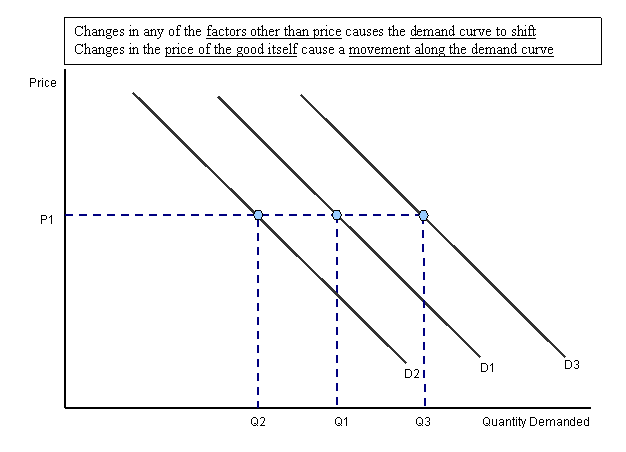 Changes
in any of the factors other than price cause the demand curve to
shift. Changes in the price of the good itself cause a movement along
the demand curve.
Changes
in any of the factors other than price cause the demand curve to
shift. Changes in the price of the good itself cause a movement along
the demand curve.
Changing prices of a substitute good
Substitutes are goods in competitive demand and act as replacements for another product.
For example, a rise in the price of Esso petrol should cause a substitution effect away from Esso towards competing brands. A fall in the monthly rental charges of cable companies or Vodafone mobile phones might cause a decrease in the demand for British Telecom services. Consumers will tend over time to switch to the cheaper brand or service provider. When it is easy and cheap to switch, then consumer demand will be sensitive to price changes.
Much depends on whether consumers have sufficient information about prices for different goods and services. One might expect that a fall in the charges from one car rental firm such as Budget might affect the demand for car rentals from Avis Hertz or Easycar. But searching for price information to get the best deal in the market can be time consuming and always involves an opportunity cost. The development of the internet has helped to increase price transparency thereby making it easier for consumers to compare relative prices in markets.
Changing price of a complement
Two complements are said to be in joint demand. Examples include: fish and chips, DVD players and DVDs, iron ore and steel. A rise in the price of a complement to Good X should cause a fall in demand for X. For example an increase in the cost of flights from London Heathrow to New York would cause a decrease in the demand for hotel rooms in New York and also a fall in the demand for taxi services both in London and New York. A fall in the price of a complement to Good Y should cause an increase in demand for Good Y. For example a reduction in the market price of computers should lead to an increase in the demand for printers, scanners and software applications.
Change in the income of consumers
Most of the things we buy are normal goods. When an individual’s income goes up, their ability to purchase goods and services increases, and this causes an outward shift in the demand curve. When incomes fall there will be a decrease in the demand for most goods.
Change in tastes and preferences
Changing tastes and preferences can have a huge effect on demand. Persuasive advertising is designed to cause a change in tastes and preferences and thereby create an outward shift in demand. A good example of this is the recent surge in sales of smoothies and other fruit juice drinks.
The law of supply states that, ceteribus paribus (latin for 'assuming all else is held constant'), the quantity supplied for a good rises as the price rises. In other words, the quantity demanded and price are positively related. Supply curves are drawn as 'upward sloping' due to this positive relationship between price and quantity supplied. Note: There are theoretical instances where the law of supply might not hold, though these are rarely, if ever, seen in the real world.
10. Market balance passes in a new point on the schedule as the excise tax operates on the consumer hence at increase in the price demand for the goods falls therefore there is a new equilibrium price because the offer also moves in a new point.
11. The government gains from the introduction of excise tax. The excise is an important source of incomes of the state budget of the modern countries. The size of the excise on many goods reaches half, and sometimes 2/3 their prices.
12. An economic measure of consumer satisfaction, which is calculated by analyzing the difference between what consumers are willing to pay for a good or service relative to its market price. A consumer surplus occurs when the consumer is willing to pay more for a given product than the current market price.
14. Producer surplus or producers' surplus is the amount that producers benefit by selling at a market price that is higher than the least that they would be willing to sell for. « What are the factors that determine its size»?
15. Time makes direct impact on balance of the market. Eventually can change both demand, and the offer. Any reason of change of demand or the offer directly depends on time. Demand: 1) Change of tastes of consumers 2) Change of the income of consumers 3) Change of number of consumers The supply: 1) Change of quality of used resources 2) Change of the prices of used resources 3) Change of quantity of manufacturers
16.
%change in quantity demanded= (Change in quantity demanded/Initial quantity demanded)*100 = 2% %change in price = (Change in price/Initial price)*100=1% Price elasticity of demand=2%/1%=2%
21. Diamonds - luxury goods. It is not the vital elements for existence, therefore is possible price overestimate while water vital for existence and the price should be strictly fixed
22. Да, я согласен, так как кривая спроса показывает зависимость количества покупаемого товара от его цены. Чем выше цена, тем меньше покупается товар. В таком случае, чем меньше эластичность спроса, тем больше уменьшается кол-ва покупаемого товара при меньшем уменьшении цены. Кривая спроса показывает, насколько сильно товар необходим потребителю. Или сколько товаров он готов купить за определенную цену.
Yes, I agree, because the demand curve shows dependence of quantity of the bought goods on its price. The above the price, the is less bought the goods. In that case, the elasticity of demand there is less, the decreases a quantity of the bought goods at smaller reduction of the price more. The demand curve shows, how much strongly the goods are necessary for the consumer. Or how many the goods he is ready to buy for determined price.
26. Difference between Absolute Advantage and Comparative Advantage
A nation's absolute advantage is measured in relation to other nations. A nation has an absolute advantage in the production of a product any time it can produce that product at a lower cost than can other nation. A nation's comparative advantage is measured in relation to all of the goods and services the nation produces. A nation has a comparative advantage in those products that have the lowest opportunity costs.
By specializing in the production of the product it can produce most efficiently, each nation is able to make the best use of its available resources. International trade then allows each nation to enjoy the most products at the lowest opportunity costs.
27. The basic theory of comparative advantage was developed by David Ricardo Сomparative advantage exists when a country has a margin of superiority in the production of a good or service i.e. where the opportunity cost of production is lower.
Ricardo's theory of comparative advantage was further developed by Heckscher, Ohlin and Samuelson who argued that countries have different factor endowments of labour, land and capital inputs. Countries will specialise in and export those products which use intensively the factors of production which they are most endowed.
If each country specialises in those goods and services where they have an advantage, then total output and economic welfare can be increased (under certain assumptions). This is true even if one nation has an absolute advantage over another country.
For mutually beneficial trade to take place, the two nations have to agree an acceptable rate of exchange of one product for another. To work this out, consider the internal opportunity cost ratios for each country.
28. The two main determinants of the position of the PPF at any given time are the state of technology and management expertise (which are reflected in the available production functions) and the available quantities and productivity of factors of production. Only points on or within a PPF are actually possible to achieve in the short run. In the long run, if technology improves or if the productivity or supply of factors of production increases, the economy's capacity to produce both goods increases, i.e., economic growth occurs. This increase is shown by a shift of the production-possibility frontier to the right. Conversely, a natural, military or ecological disaster might move the PPF to the left, in response to a reduction in an economy's productivity. Thus all points on or within the curve are part of the production set, i.e., combinations of goods that the economy could potentially produce.
If the two production goods depicted are capital investment (to increase future production possibilities) or current consumption goods, the PPF can represent, how the higher investment this year, the more the PPF would shift out in following years. It can also represent how a technological progress that more favors production possibilities of one good, say Guns, shifts the PPF outwards more along the Gun axis, "biasing" production possibilities in that direction. Similarly, if one good makes more use of say capital and if capital grows faster than other factors, growth possibilities might be biased in favor of the capital-intensive good.
There are different ways of interferencing between the state and market economy. The state can expose excise taxes, which can fall either on consumers or on producers. The tax revenue from this tax is the profit of the state, it is equal to the Q multiplied by the amount of tax price.
Another way of influencing the market economy is trade protection. This is the policy that limit imports in the case of international trade. It, too, can fall either on producers or on consumers A tariff is a form of excise tax, one that is levied only on sales of imported goods. For example, the U.S. government could declare that anyone bringing in shrimp from Vietnam must pay a tariff of $1,000 per ton. In the distant past, tariffs were an important source of government revenue because they were relatively easy to collect. But in
t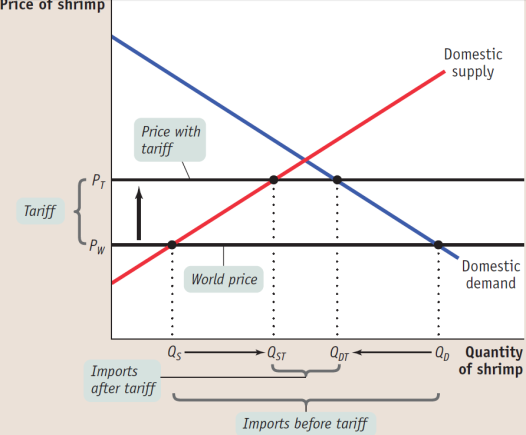 he
modern world, tariffs are usually intended to discourage imports and
protect import-competing domestic producers rather than as a source
of government revenue.
he
modern world, tariffs are usually intended to discourage imports and
protect import-competing domestic producers rather than as a source
of government revenue.
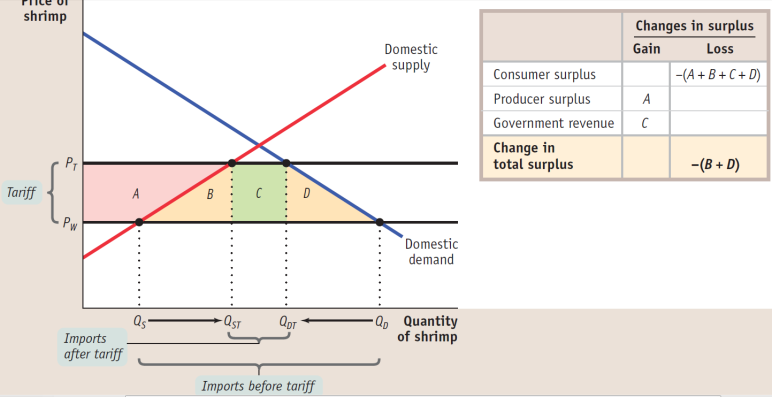
For example,what if the equilibrium between supply and demand for apartments in a major city leads to rental rates that an average working person can’t afford? In that case, a government
might well be under pressure to impose limits on the rents landlords can charge. Sellers, however, would always like to get more money for what they sell, and sometimes they can make a strong moral or political case that they should receive higher prices. For example, consider the labor market: the price for an hour of a worker’s time is the wage rate. What if the equilibrium between supply and demand for less skilled workers leads to wage rates that yield an income below the poverty level?
In that case, a government might well be pressured to require employers to pay a rate
no lower than some specified minimum wage.
I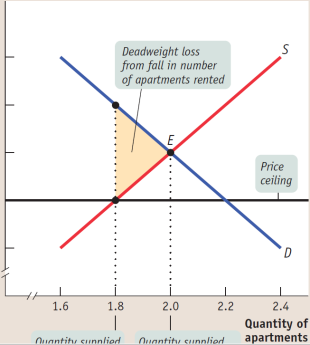
 n
other words, there is often a strong political demand for governments
to intervene in markets. And powerful interests can make a compelling
case that a market intervention favoring them is “fair.” When a
government intervenes to regulate prices, we say that it imposes
price
controls. Price
controls are
legal restrictions on how high or low a market price may go. They can
take two forms: a price
ceiling, a
maximum price sellers are allowed to charge for a good or service, or
a price
floor, a
minimum price buyers are required to pay for a
n
other words, there is often a strong political demand for governments
to intervene in markets. And powerful interests can make a compelling
case that a market intervention favoring them is “fair.” When a
government intervenes to regulate prices, we say that it imposes
price
controls. Price
controls are
legal restrictions on how high or low a market price may go. They can
take two forms: a price
ceiling, a
maximum price sellers are allowed to charge for a good or service, or
a price
floor, a
minimum price buyers are required to pay for a
good or service.
13. Price of demand is the price at which the consumer is ready to buy the good. And market price – the same price, which all the sellers receive and all the buyers buy.
2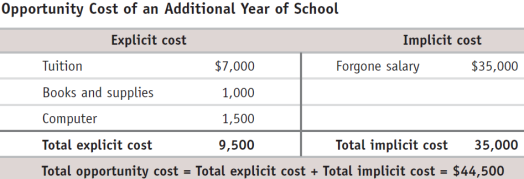 5.
Because resources are scarce, the true cost of anything is its
opportunity
cost—that
is, the real cost of something is what you must give up to get it.
The opportunity cost, like any cost, can be broken into two parts:
the explicit
cost and
the implicit
cost. An
explicit
cost is
a cost that requires an outlay of money. For example, the explicit
cost of the additional year of schooling includes tuition. An
implicit
cost, though,
does not involve an outlay of money; instead, it is measured by the
value, in dollar terms, of the benefits that are forgone. For
example, the implicit cost of the year spent in school includes the
income you would have earned if you had taken a job instead.
5.
Because resources are scarce, the true cost of anything is its
opportunity
cost—that
is, the real cost of something is what you must give up to get it.
The opportunity cost, like any cost, can be broken into two parts:
the explicit
cost and
the implicit
cost. An
explicit
cost is
a cost that requires an outlay of money. For example, the explicit
cost of the additional year of schooling includes tuition. An
implicit
cost, though,
does not involve an outlay of money; instead, it is measured by the
value, in dollar terms, of the benefits that are forgone. For
example, the implicit cost of the year spent in school includes the
income you would have earned if you had taken a job instead.
Total opportunity cost = Total explicit cost + total implicit cost
30. Market equilibrium occurred at point, where the supply curve and the demand curve intersect. In equilibrium, the quantity demanded is equal to the quantity supplied. A competitive market is in equilibrium when price has moved to a level at which the quantity of a good or service demanded equals the quantity of good or service supplied. And market-clearing level is the level(or price) that “clears the market” by ensuring that every buyer willing to pay that price finds a seller willing to sell at that price and vice versa. In other words.
3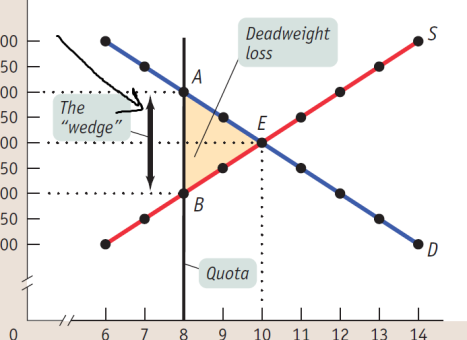 1.
The difference between the demand and supply price at the quota limit
is the quota
rent,
the earnings that accrue to the license-holder from ownership of the
right to sell the good. It is equal to the market price of the
license when the licenses are traded. The quota rent accrue to the
owner of license.
1.
The difference between the demand and supply price at the quota limit
is the quota
rent,
the earnings that accrue to the license-holder from ownership of the
right to sell the good. It is equal to the market price of the
license when the licenses are traded. The quota rent accrue to the
owner of license.
On the graph the difference between 2 prices is the quota rent per ride. Wedge is a quota rent.
32. Black markets occur as the basis of the inefficiency of the price ceilings, which provide the incentive
for illegal activities. What’s wrong with black markets? In general, it’s a bad thing if people break any law, because it encourages disrespect for the law in general. Worse yet, in this case illegal activity worsens the position of those who try to be honest. If the Lees are scrupulous about upholding the rent-control law but other people—who may need an apartment less than the Lees—are willing to bribe landlords, the Lees may never find an apartment. Goods acquired illegally are cheaper than legal market prices. The supplier does not have to pay for production costs or taxes. This is usually the case in the underground economy. Criminals steal goods and sell them below the legal market price, but there is no receipt, guarantee, and so forth.
33. The produced goods possess the inefficiently high quality in the terms of the price floor. It means that sellers offer high-quality goods at a high price, even though buyers would prefer a lower quality at a lower price.
34. The inefficient allocation of sales among sellers appears in the terms of the price floor. Inefficient allocation of sales among sellers means that those, who would be willing to sell the good at the lowest price are not always those, who actually manage to sell it.
35. Inefficient allocation to consumers: Price ceilings often lead to inefficiency in the form of inefficient allocation to consumers: people who want the good badly and are willing to pay a high price don’t get it, and those who care relatively little about the good and are only willing to pay a low price do get it. For example in the situation with an inefficient distribution of apartments: some people who are not especially anxious to find an apartment will get one and others who are very anxious to find an apartment won’t. Because people usually get apartments through luck or personal connections under rent control, it generally results in an inefficient allocation to consumers of the few apartments available.
Inefficient allocation to consumers also leads to a loss of surplus over and above the deadweight loss.
36. Yet another way a price ceiling causes inefficiency is by causing goods to be of inefficiently low quality. Inefficiently low quality means that sellers offer low-quality goods at a low price even though buyers would rather have higher quality and are willing to pay a higher price for it.
38. both quotas and taxes are set by state. A quota is an upper limit on the Quantity of some good that can be bought or sold. And tax is charged on each unit of a good or service that is only sold.
Еще????
39.I way. To calculate the price elasticity of demand, we first calculate the percent change in the quantity demanded and the corresponding percent change in the price as we move along the demand curve.
% change in quantity demanded= (change in Q demanded/initial quality demanded)*100
And
% change in price= (change in price/initial price)*100
Then to calculate the price elasticity of demand we find the ratio of the percent change in the Q demanded to the percent change in price:
% price elasticity of demand=% change in Q demanded/ % change in price
I I
way.
The midpoint method is a technique for calculating the percent
change. In this approach, we calculate changes in a variable compared
with the average of the starting and final values.
I
way.
The midpoint method is a technique for calculating the percent
change. In this approach, we calculate changes in a variable compared
with the average of the starting and final values.
45. No! A proportional tax is the same percentage of the base regardless of the taxpayer’s income
or wealth. For example, a property tax that is set at 2% of the value of the property,
whether the property is worth $10,000 or $10,000,000, is a proportional tax. And a lump-sum tax, a tax that is the same for everyone regardless of any actions people take. It was widely perceived as much less fair than the tax structure it replaced, in which local taxes were proportional to property values. In contrast, a lump-sum tax does not distort incentives. Because under a lump-sum tax people have to pay the same amount of tax regardless of their actions, it does not lead them to change their actions and therefore causes no deadweight loss. So lump-sum taxes, although unfair, are better than other taxes at promoting economic efficiency.
47. There are two principles of tax fairness. When it comes to taxes most debates about fairness rely on one of two principles of tax fairness: the benefits principle and the ability-to-pay principle. According to the benefits principle of tax fairness, those who benefit from public spending should bear the burden of the tax that pays for that spending. For example, those who benefit from a road should pay for that road’s upkeep, those who fly on airplanes should pay for air traffic control, and so on.
According to the ability-to-pay principle of tax fairness, those with greater ability to pay a tax should pay more tax. The ability-to-pay principle is usually interpreted to mean that high-income individuals should pay more in taxes than low-income individuals. Often the ability-to-pay principle is used to argue not only that high-income individuals should pay more taxes but also that they should pay a higher percentage of their income in taxes.
48. Impact of tax:
A Tax Reduces Consumer and Producer Surplus
B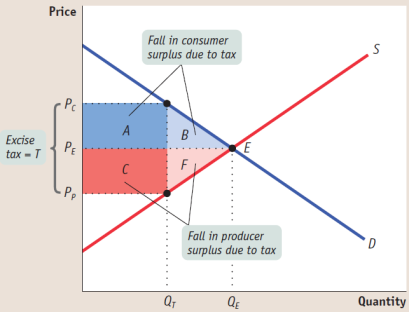 efore
the tax, the equilibrium price and quantity are PE
and
QE,
respectively.
After an excise tax of T
per
unit is imposed, the price to consumers rises to PC
and
consumer surplus falls by the sum of the dark blue rectangle, labeled
A,
and
the light blue triangle, labeled B.
The
tax also causes the price to producers
efore
the tax, the equilibrium price and quantity are PE
and
QE,
respectively.
After an excise tax of T
per
unit is imposed, the price to consumers rises to PC
and
consumer surplus falls by the sum of the dark blue rectangle, labeled
A,
and
the light blue triangle, labeled B.
The
tax also causes the price to producers
to fall to PP; producer surplus falls by the sum of the dark red rectangle, labeled C, and the light red triangle, labeled F. The government receives revenue from the tax, QT × T, which is given by the sum of the areas A and C. Areas B and F represent the losses to consumer and producer surplus that are not collected by the government as revenue; they are the deadweight loss to society of the tax.
